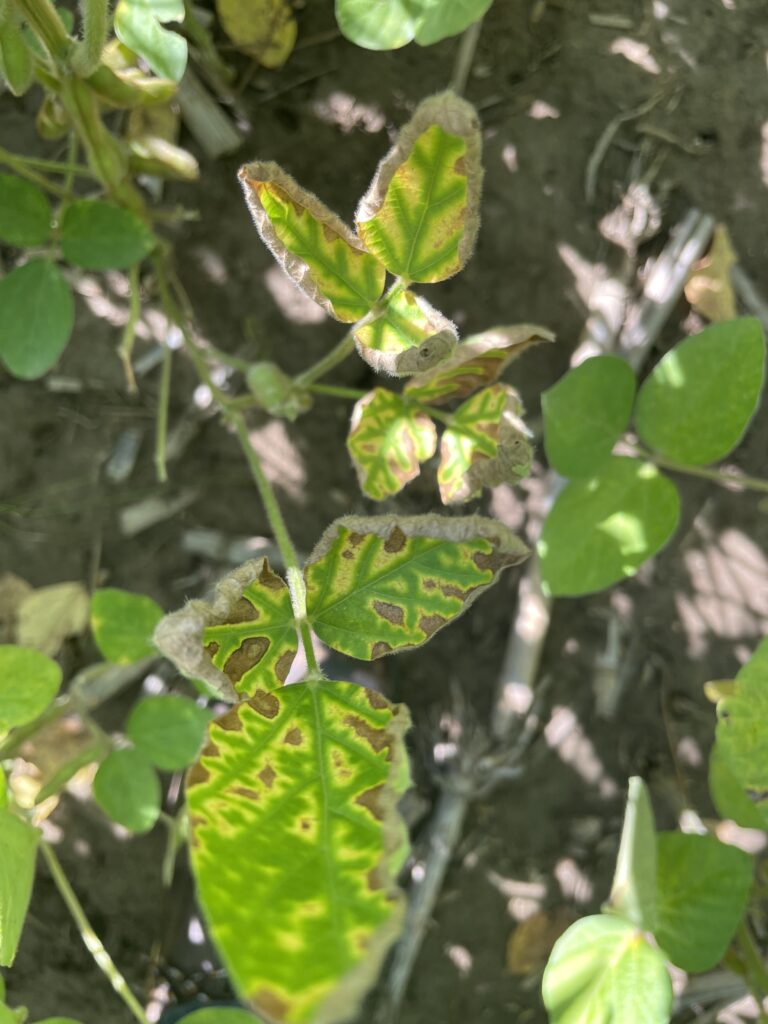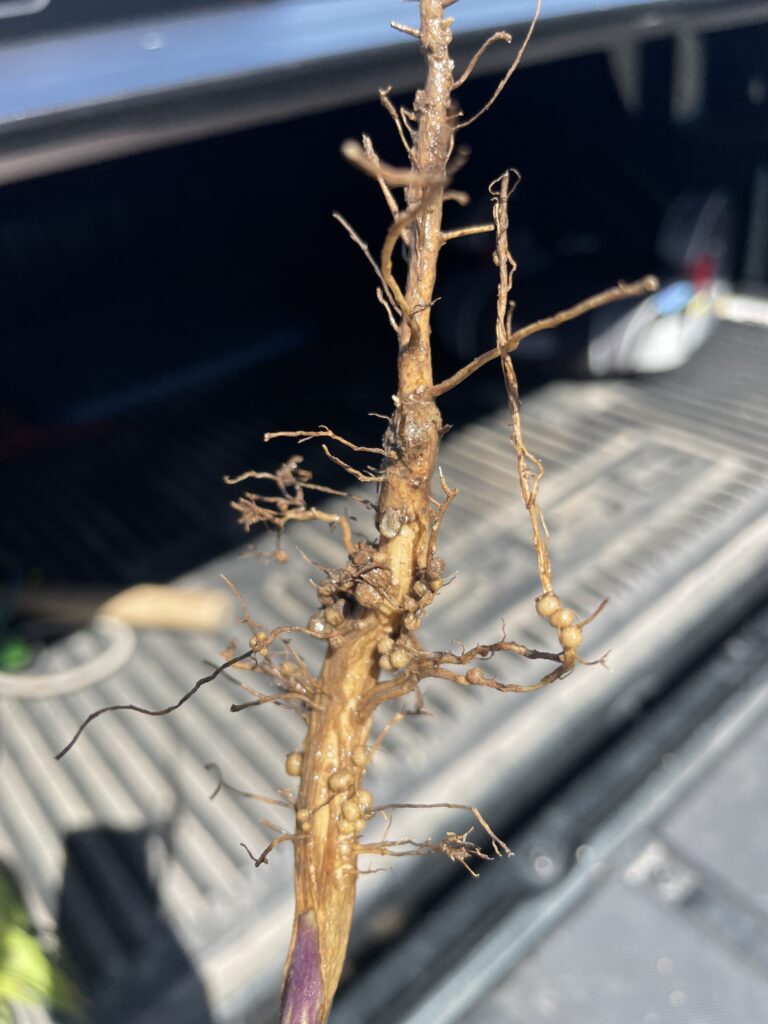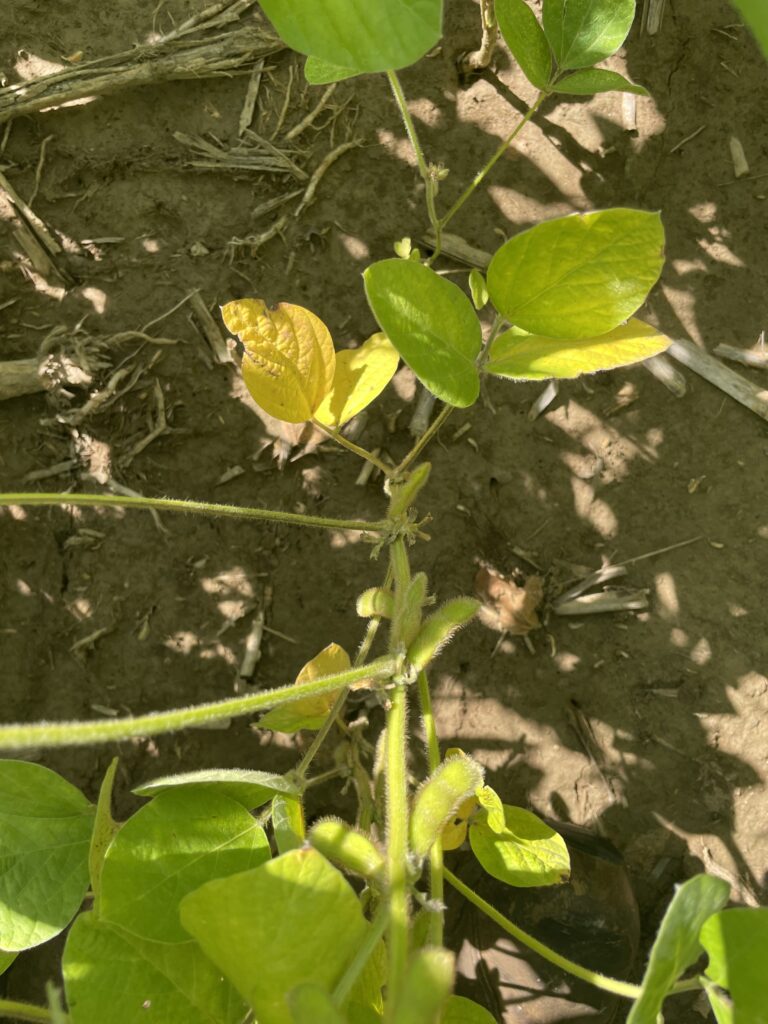I know that many farmers and agronomists want everything to be black and white or “one answer”. I have found, especially this year, that there could be several things going on in the field that could have a domino effect and eventually lead to disease. Therefore, it is best to use this 10-step process to fully evaluate what could be going on in the soybean field.
Here’s an example below that was recently emailed to me.
Wanted to share a few pics of a bean field of a grower of mine from Northern Illinois that was having issues this year and wanted to get your thoughts on it.
One seed dealer who looked at this said textbook red crown rot, but I did not see any symptoms of this disease that we have recently been learning about.
Timber clay coarseness in the field, “Brand 1” Variety beans, with X seed treatment….
Across the fence, was “Brand 2” Variety beans with Y and SDS/SCN seed treatment and was not as bad.
Big yellowing patches that had way less nodules, leaves and pods obviously…
Leaf symptoms
The foliar symptoms in the pictures provided looked to be the symptom of several different diseases: sudden death syndrome, brown stem rot, red crown rot, or stem canker. This is because the fungal pathogen of all these diseases sends a toxin up to the leaves that can cause the same interveinal leaf necrosis or leaf symptoms that you saw in this field.
Step 1: Rule out brown stem rot by cutting the stem open and checking the inner pith in the center of the stem for browning, especially in the lower nodes. A healthy soybean stem pith will be white.
Step 2: Rule out stem canker by checking for cankers or reddish brown lesions, often near stem nodes, on the outside of the stem. The trick is seeing green stem tissue above and below each stem canker. Be careful because when you cut the stem open, there could be brown discoloration within the cankered area of the stem. Don’t confuse it with brown stem rot or phytophthora root rot.
Step 3: Rule out red crown rot by looking for reddening on the outside at the lower stem as well as tiny red perithecia or fruiting structures that may or may not be present. Late into the season, red crown rot can be too deteriorated and difficult to diagnose.
Step 4: Sudden death syndrome (SDS) will cause the vascular tissue in the lower stem and root system to be a brown to gray color. The stem pith will be white. If soil conditions are moist, you might see a bluish fungus growing on the root surface; however, it is NOT always present. Leaves will drop or detach from the petioles as the disease progresses. Other diseases will hold on to their leaves.
Lower stem and root symptoms
Step 5: If you still are not confident with your diagnosis, you can always send a sample to the Plant Disease Clinic and that is what happened in this case. The Plant Clinic diagnosed the sample from this field with Sudden Death Syndrome and Fusarium crown rot.
Step 6: What is the SDS score of Brand 1 variety verses Brand 2 variety?
Steph 7: What was the seed treatment package of Brand 1 verses Brand 2 variety? Did one variety consist of a seed treatment that could be used to combat SDS and soybean cyst nematode (SCN)?
Step 8: Did you check for SCN on the roots or the soil? Soybean cyst nematode can be a visual indicator and make soybeans more prone to diseases such as SDS (as well as other disease such as Brown stem rot and red crown rot). Have you heard that the U of I is offering FREE SCN (Egg Count) Sampling and it’s funded by ISA?
Step 9: Was the area where you found the disease low lying or compacted? Since the individual mentioned that there was a lack of nodulation and found SDS, I can only assume that this could be an area of this timber clay soil that could be holding water. Excessive water or flooding will cause less nodulation as well as other issues such as disease, drought, and high pH. Lack of nodulation can of course lead to a nitrogen deficiency or soybeans that are light green in color.
Light green color of soybean due to root rot, SCN, lack of nodulation, or nutrient deficiency.
Step 10: Could you have areas of the field that are sulfur deficient? Rule out disease, SCN injury, pH issues, and nitrogen (N) deficiency. Extreme moisture or extreme dry conditions, along with cold weather, can reduce microbial activity and reduce sulfur (S) availability from soil organic matter or crop residues. However, S is not as mobile in the plant as N, so lower leaves do not show more severe deficiency symptoms than the upper leaves. If a S deficiency is misdiagnosed as a N deficiency, the application of fertilizer N will make the S deficiency worse, so tissue sampling (in deficient verse healthy areas) is recommended to positively identify which nutrient is deficient.





 and then
and then
could i send you a picture of soybean root ? to a text number if possible tks terry
Hello Terry, I just reached out and sent you an email as well as other contact information if you would like to send me a picture to evaluate.